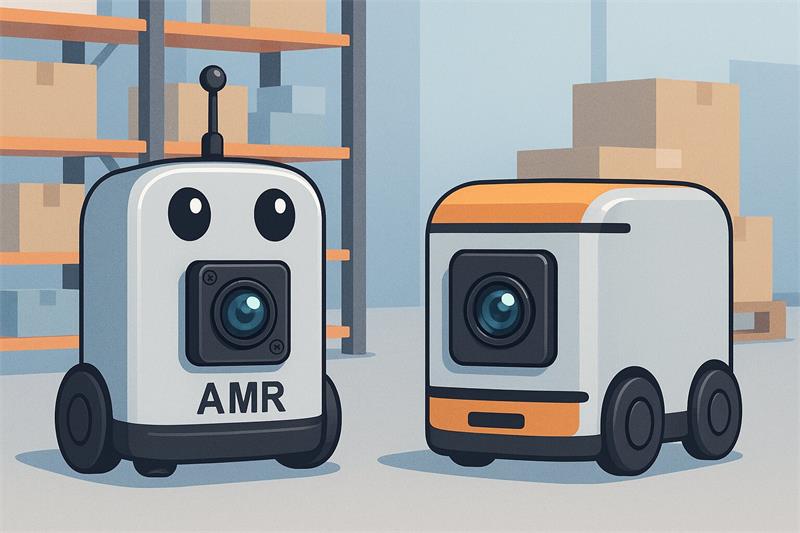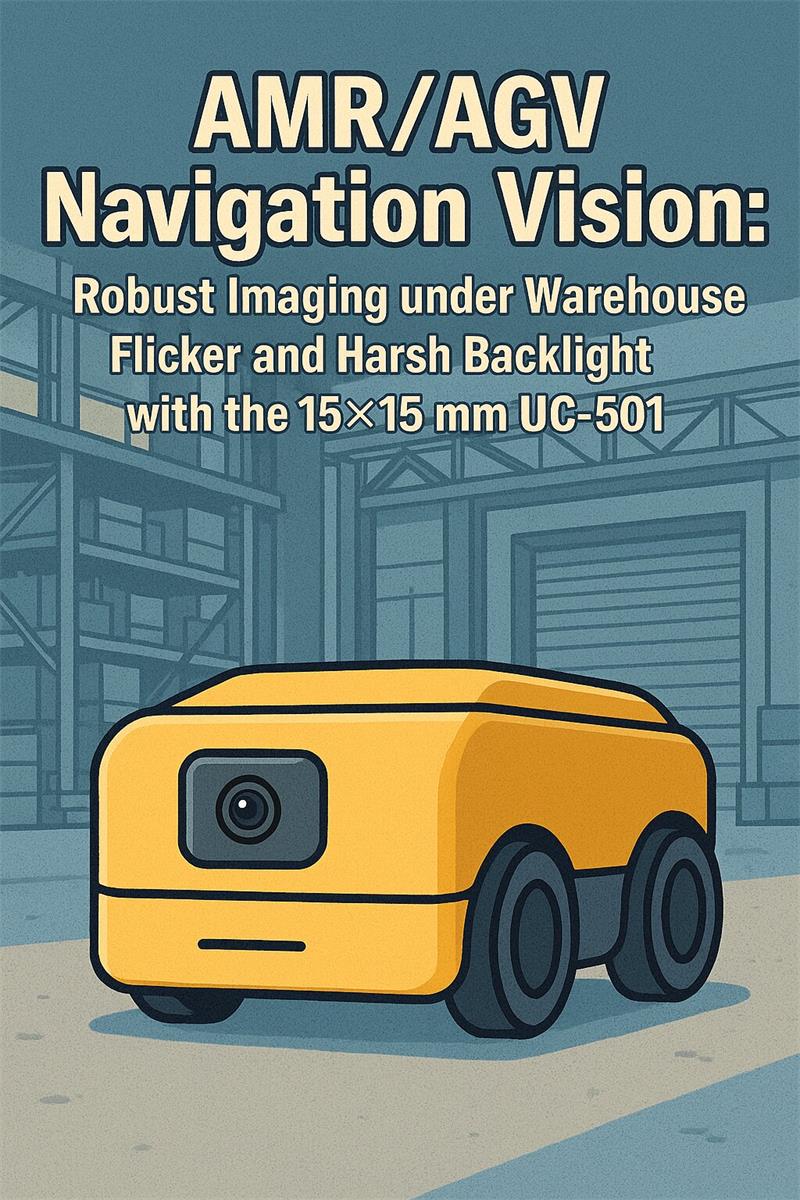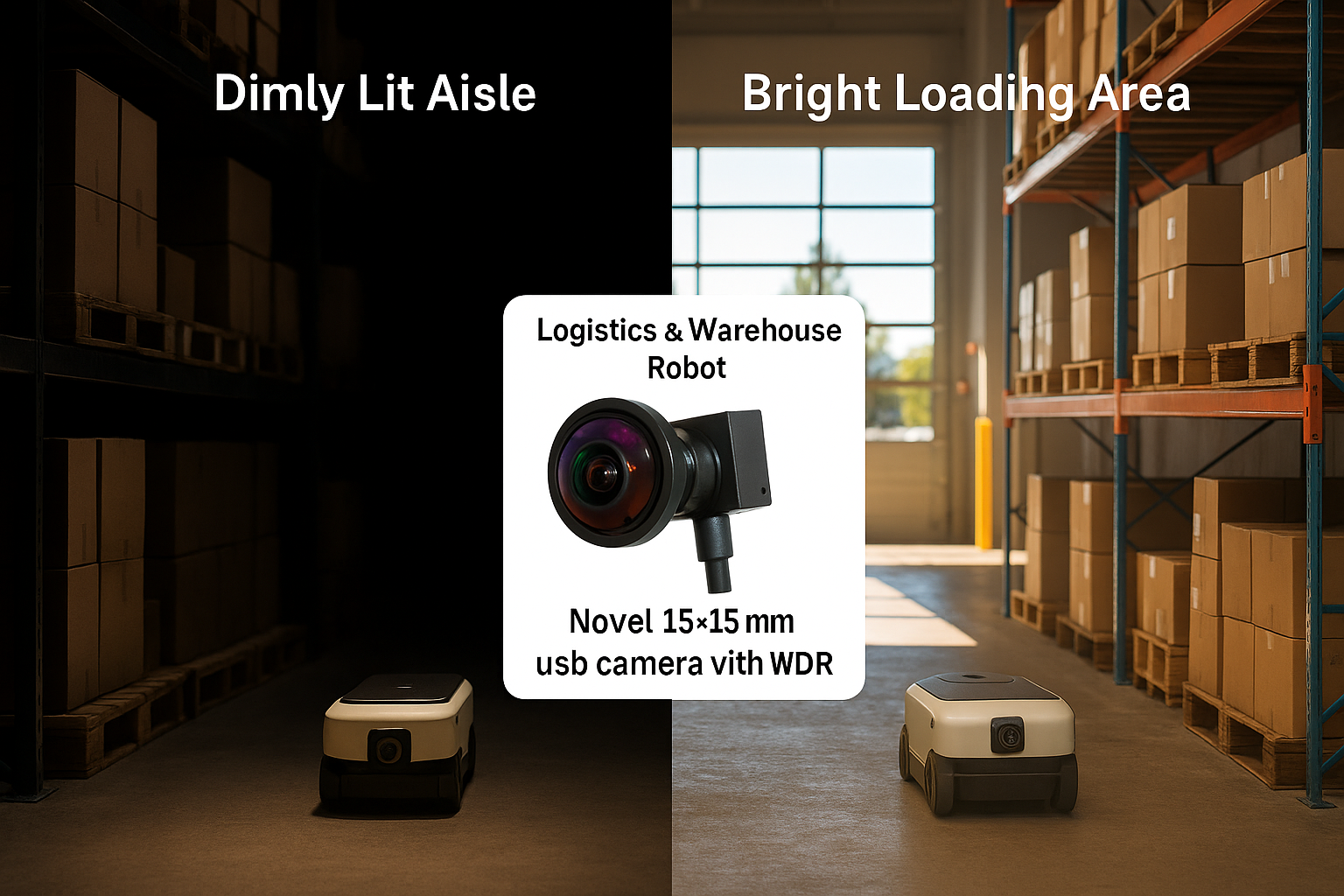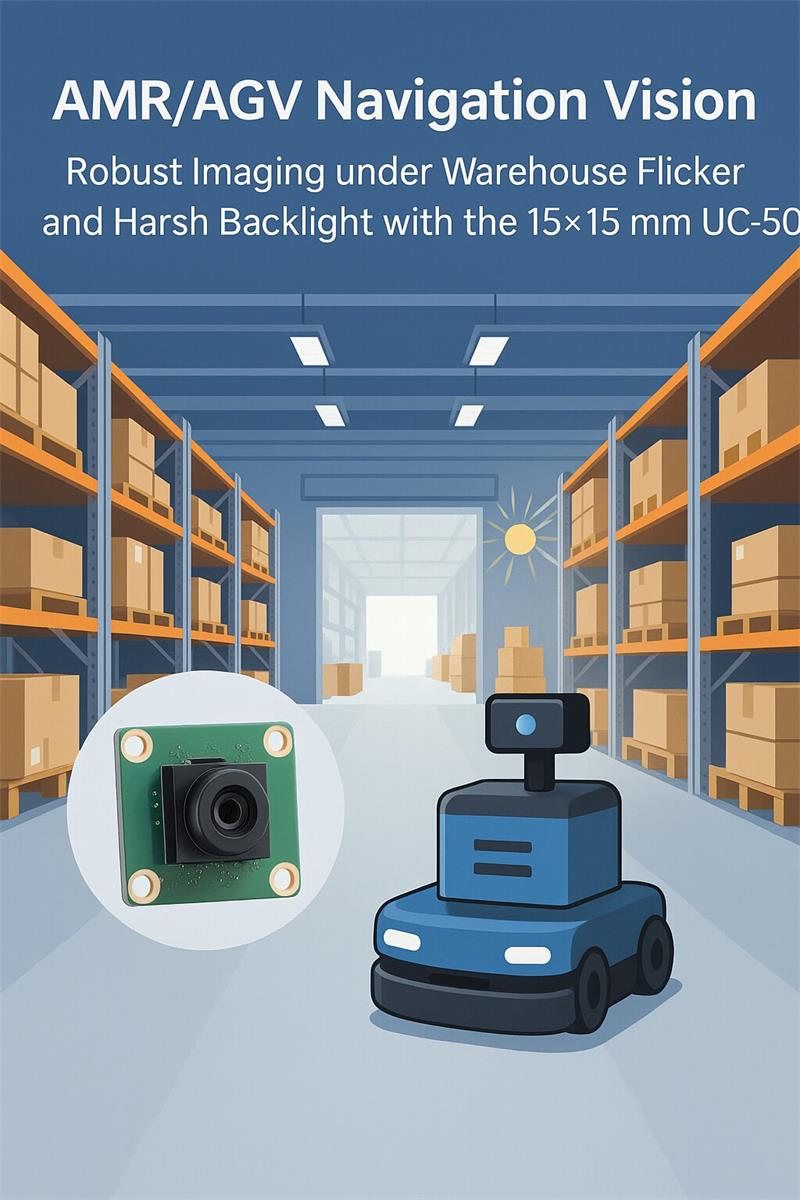
Modern warehouses mix bright LED arrays, skylights, open dock doors, and glossy surfaces. That environment breaks fragile vision pipelines: images breathe as exposure hunts, geometry warps under glare, and navigation accuracy drifts. This article gives a hands-on blueprint for stabilizing AMR and AGV navigation with the UC-501 15×15 mm mini USB camera—a compact UVC-class module designed for embedded robotics. You will learn why flicker happens, how to pick exposure times that avoid it, how to tune WDR without losing temporal stability, how to wire power and shielding to stop intermittent drop frames, how to stand up a ROS2 pipeline on Jetson in a day, and how to measure reliability with simple quantitative metrics.
LED or fluorescent lighting often runs from rectified mains. Luminance fluctuates at 100 Hz in 50 Hz regions and 120 Hz in 60 Hz regions. If your exposure integrates across a time window that does not align with those cycles, the camera records different energy each frame, creating a brightness oscillation that SLAM and feature trackers mistake for scene change. Backlight from dock doors or high bay skylights compounds the problem by pushing parts of the frame into saturation while adjacent areas remain underexposed. The net effect is unstable corner detection, jitter in visual odometry, and an elevated relocalization rate.
The simplest anti-flicker method is exposure time locking to a reciprocal of the flicker frequency. In practice, set exposure to multiples of:
When you need faster shutter for motion, use exact submultiples (1/200, 1/400, or 1/240, 1/480). Pair that with a moderate gain profile so you preserve signal without amplifying noise. On Linux you can enforce this with UVC or v4l2:
v4l2-ctl -d /dev/video0 --set-ctrl=exposure_auto=1 \
--set-ctrl=exposure_absolute=10 # ≈ 1/100 s (units vary by driver)
Keep auto exposure disabled during navigation passes; enable a slow, bounded auto mode only at mission start or when the robot detects sustained illumination change.

WDR helps with backlit aisles and reflective totes but can introduce frame-to-frame tone mapping shifts. Use a two-stage recipe:
The goal is not maximum instantaneous dynamic range; it is predictable gradients and repeatable features. Navigation likes continuity.
For a robot traveling at velocity v (mm/s), imaging at focal length f (pixels/mm on the sensor), motion blur in pixels scales with v × t × f, where t is exposure time. If your feature tracker tolerates 0.5 px blur, solve for t ≤ 0.5 / (v × f). Typical warehouse speeds and common pixel pitches often land you near 1/200–1/400 s. That interacts with anti-flicker, so choose 1/240 or 1/480 in 60 Hz regions and compensate with gain and lens aperture. UC-501 variants support small M7/M8 lenses with bright apertures that help keep shutter fast without excessive gain.
End-effector or mast mounting space is scarce. The UC-501 foot-print is 15×15 mm, leaving room for a short-flange lens. For navigation, pick a horizontal FOV around 80–95° to balance horizon coverage with limited distortion. Wider lenses make lines bow and degrade pose estimation unless rectified. Mount the lens centerline near the robot’s yaw axis and keep the optical center above the base footprint to reduce parallax during tight turns. Add a very shallow hood (1–2 mm extension) to block high-angle glare from LED troffers without vignetting.

Robots carry motor drivers, switching supplies, radios, and batteries. Poor layout injects EMI into the USB differential pair causing snow noise or frame drops. Follow this checklist:
Because UC-501 is UVC-class, you can bring up a ROS2 image stream in minutes:
sudo apt-get install v4l-utils
v4l2-ctl -d /dev/video0 --set-fmt-video=width=1280,height=720,pixelformat=YUYV
# ROS2 sample publisher
ros2 run image_tools cam2image --ros-args -p width:=1280 -p height:=720
Then bridge into your navigation stack using image_transport and cv_bridge. For SLAM stability, publish synchronized IMU if available. If you need H.264 to cut bandwidth for remote dev, pipe through GStreamer:
Calibrate intrinsic parameters with a high-contrast board at the working distance and operating aperture. Save a rectification map and apply it online. Repeat a short verification after thermal soak because small plastic lens barrels creep slightly with heat. If your mount sees vibration, a pin-in-slot mechanical constraint improves repeatability after service.

You do not need a full photometric lab to quantify stability. Define a 3-lane test course with alternating high-intensity bays and occluded aisles. Drive three laps with fixed exposure and three with bounded auto. Log:
Brightness variance per frame in a metering window, target < 2 %
Feature track survival length, target > 100 frames median
Relocalization count per minute, target downward trend
Navigation RMSE, measured against UWB or LiDAR baseline
If you hit variance and survival targets, SLAM will feel “glued” rather than floaty.
Add a soft brush strip or small seal around the lens hood to block dust. Set a weekly job that captures a patch chart under two fixed lights to catch drift. If images grow noisy at the same exposure, your lighting or lens may have degraded; replace before performance drops in production.
UC-501 module with selected lens and IR-cut option
Shielded USB cable cut to length plus retention clips
Polarizer or hood if glare is acute
Mounting plate with datum features for repeatable pose
v4l2 tuning script and fixed exposure profiles for 50/60 Hz regions
A printed quick-start for the ROS2 pipeline and a JSON with calibration
Product: UC-501 Mini USB Camera Module
Comparison: UC-501 Camera Comparison & Selection
Applications: UC-501 in Industrial & Robotics Vision
OEM/ODM: Custom OEM/ODM Camera Solutions
Ready to harden your AMR navigation vision?

Answer:
The UC-501 mini USB camera integrates a WDR (Wide Dynamic Range) image pipeline and anti-flicker synchronization with 50 Hz/60 Hz lighting frequencies.
By fixing exposure to fractional multiples of 1/100 s (for 50 Hz) or 1/120 s (for 60 Hz) and applying real-time luminance averaging, it prevents oscillation in frame brightness under LED or fluorescent lights. This ensures that AMR and AGV vision pipelines—such as feature tracking and SLAM—remain consistent even when robots move between bright and dim zones.
Pro Tip: UC-501’s exposure/gain profiles can be pre-tuned via v4l2-ctl scripts for specific regional power frequencies, eliminating the need for dynamic adaptation at runtime.
Answer:
Unlike consumer USB webcams, UC-501-WDR is a 15×15 mm industrial-grade usb camera module with:
WDR up to 100 dB, providing balanced imaging in mixed lighting.
UVC 1.1 compliance, ensuring driverless integration on Jetson, Linux, or Windows.
Shielded PCB design and low-EMI components for high electromagnetic immunity.
Long-life components rated for 24/7 embedded operation.
Customizable lens options (M7/M8/M12) for precise FOV and depth control.
These factors make UC-501 more reliable for long-term AMR/AGV deployment compared to generic webcams.
Answer:
UC-501 is fully UVC-class compliant, meaning no proprietary SDK is required.
It works immediately with v4l2, image_tools, and ROS2 nodes. Engineers can launch a working video stream in minutes:
ros2 run image_tools cam2image --ros-args -p width:=1280 -p height:=720
For AI inference, the same UVC feed can be piped to OpenCV, ONNXRuntime, or TensorRT without format conversion.
For developers, Shenzhen Novel Electronics provides a Jetson Quick-Start pack containing sample launch.xml, exposure profiles, and calibration data for ROS2-based navigation.
This plug-and-play design helps product teams reduce software integration time by up to 60 %.
Answer:
Yes. The UC-501 is engineered for electrical noise and vibration resilience:
The module uses a fully shielded USB cable and isolated ground to prevent image noise from motor drivers or power circuits.
It passes vibration tests up to 5 g RMS (XYZ 10–500 Hz) and supports FPC/USB connector retention options to prevent loosening during robot movement.
Optional ferrite filters and braided cables further improve signal integrity.
In field tests, UC-501 operated continuously in a 4-wheel AMR at 3 m/s with no frame drop or USB reset for 100 hours.
Answer:
shenzhen Novel Electronics Limited offers full OEM/ODM customization around the UC-501 platform:
Sensor options: 2 MP / 5 MP / 8 MP Sony STARVIS (IMX291, IMX335, IMX415).
Interfaces: USB 2.0 / USB 3.0 / Type-C / FPC direct mount.
Lens systems: 5°–220° FOV, IR-cut, polarized, or autofocus versions.
Firmware tuning: exposure curves, gain limits, 3A algorithms, and HDR parameters.
Mechanical options: board-level, housing with bracket, or full IP65-sealed module.
For OEM projects, all tuning files and calibration data can be serialized with the customer’s logo and part number.
Contact: office@okgoobuy.com for ODM specification sheets or mechanical CAD drawings
Note & Remarks/Relative Blog& articles of Robots version camera module
1, Compact WDR USB Camera for Next-Gen EoAT & AMR Robotics Vision
2, Custom Embedded Vision Camera Modules for Robotics
3, Custom Micro USB Camera for Robots Guide UC-501
4, Why Robots Need Micro WDR USB Cameras UC-501-WDR?
5, Novel Manufacture ltd launch 15x15mm WDR USB Camera for Robots
6, WDR Miniature USB Camera for Robotics, Kiosks & Vending & IOT UC-501-WDR